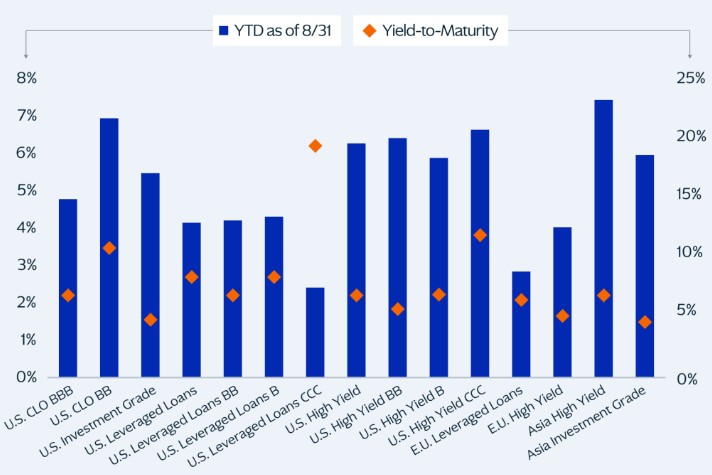KKR's 2025 playbook for credit markets
The film Back to the Future opens with a wall of ticking clocks: some broken, some in sync, all measuring time but telling different stories. It is a fitting metaphor for today’s credit markets, where speed, timing, and structure matter more than ever. If Doc Brown were around today, he wouldn’t need to power the DeLorean himself. With access to an array of financing options, from sale-leasebacks to venture capital, he could bring in the right partners, align capital to purpose, and get his machine on the road. The market of 2025 looks nothing like the world of 1985, when Doc and Marty McFly first hit 88 miles per hour. But in some ways, Back to the Future got the arc right: it imagined a world where disconnected technologies — video, communication, navigation — converged into a single machine. Decades later, that vision feels familiar within the credit markets.
Today, while the basic function of connecting borrowers and lenders remains, the architecture has evolved. What was once a rigid system of siloed instruments has become a dynamic, cross-asset interface that is customizable, modular, and integrated. As we wrote at the start of the year, this is no longer a world of standalone loans or bonds. It’s an integrated ecosystem of multiple financing lanes, where public and private markets intersect and investors operate across structures, geographies, and risk profiles. The real difference between now and 1985 (or even 1955) is the toolkit. We now have the infrastructure to facilitate access for a broader set of issuers and investors, enabling capital to flow with greater speed, precision, and purpose. In that way, perhaps the true flux capacitor of our time is the modern capital markets system itself. Although, without sufficient M&A and capital markets activity, there could be a glitch in the system.
Indeed, we have been emphasizing for some time the critical link between M&A and credit markets, particularly in the leveraged loan and direct lending market, a connection coming into even sharper focus now. While M&A activity lagged expectations earlier this year, contributing to a widening of the supply/demand gap, recent quarters have shown a modest turnaround. This time, strategics are leading rather than sponsors with corporate-to-sponsor transactions, corporate carve-outs, and structured equity taking center stage. But we should not get ahead of ourselves: activity is improving, but not sufficient yet.
Like Doc Brown’s flux capacitor, we believe today’s market demands precision and ingenuity. However, instead of 1.21 gigawatts of raw power, it runs on creative structuring and cross-asset solutions. These tools would have been foreign to most in the 1980s, except for a few visionaries who helped shape the market. Back in 1989, the leveraged finance market was predominantly high yield bonds and totaled ~$189 billion. Today, the U.S. high yield is $1.5 trillion. But more importantly, the opportunity set has transformed. The total addressable global credit market now spans more than $45 trillion across corporate, asset-based and structured credit. This growth has been fueled by innovation, the globalization of capital flows, structural demand for diversified income, broadened access and the institutionalization of origination.
In our May note “V for Volatility: Part II?” we emphasized that not all volatility is created equal, a distinction powerfully underscored on Liberation Day. The volatility we saw in Q2 demonstrated the credit markets' enhanced ability to distinguish signals from noise, displaying remarkable resilience relative to listed equities or rules-based products such as ETFs and CLOs. This resilience supports our continued stance in a carry over convexity environment, especially as spreads near all-time tights. At KKR, we are of the mindset that patient capital strategies are not rewarded for overreaching for risk to chase yield. Right now, we believe it is important to stay selective and disciplined. We would be remiss if we did not acknowledge that markets have been slightly exuberant and we feel it is prudent to recognize the interplay between fundamentals, technicals, and investor psychology. In other words, we appreciate it has not been easy to navigate these markets.
As our colleague Henry McVey notes in “Make Your Own Luck”, the capital formation landscape is undergoing profound transformation. The growth of alternative lenders and private company formation has directly contributed to the growing demand for non-traditional financing, and that is reshaping the capital stack. The private markets are not only expanding, they are also deepening, with broader institutional participation, scale, and increasingly segmented specialization that is translating into new, non-traditional M&A.
EXHIBIT 1: Global Credit Remains a Resilient & Consistent Source of Income
Year-to-Date Returns Across Global Credit Markets

This is not just a search for yield, but rather a response to the limitations of customized financing at scale. The opportunity today lies not only in access but in insight: understanding how scaled and specialized capital can deliver both returns and resilience. That, in turn, demands sharper engagement across the financing ecosystem, from originators and operators to the stakeholders impacted by these capital flows.
Yet in many respects, the credit markets are revisiting dynamics that defined the ’80s: strategic corporate buyers deploying cash reserves, relationship-driven financing replacing off-the-shelf structures, and private capital stepping into roles traditionally engaged by banks, (predominantly high yield bonds and the emergence of bank loans). Markets are simultaneously going back to fundamentals with value and capital-light transitions while moving forward with innovative financing structures that bridge the traditional debt and equity boundaries. Like Doc’s DeLorean, today’s market is evolving to be the ultimate “partnership vehicle.” Just as Marty and Doc needed each other’s strengths to navigate time and its complexities, we are seeing unprecedented collaboration between strategics, sponsors, banks, insurers, capital allocators and asset-managers.
The old roads, traditional financing channels, are giving way to inventive financing solutions that merge the relationship-driven ethos of 1985 with the technological sophistication of 2025. Public and private markets, together, enrich the broader market, touch a wider range of constituents and provide critical access points to scaled credit for businesses to continue to operate and grow. The symbiotic relationship is real, and this is not a zero-sum game. However, successfully navigating this transformed landscape will require “making your own luck.” At KKR, we are committed to blazing new trails rather than relying on old maps. There is no question that together we can handle the journey if we are able to sustain the speed, precision, and agility necessary to capitalize on opportunities appearing, and disappearing, at precisely 88 miles per hour.
With this framework in mind, we reflect on the themes that shaped our perspective this quarter:
Level setting on markets as the wiring under the capital markets and M&A dashboard is changing
- Patience: We believe that patient capital will be rewarded. In this environment, selectivity and discipline matter more than ever.
- Breaking down silos: We continue to emphasize the importance of breaking down internal silos and integrating investment and capital markets capabilities to drive stronger outcomes.
- Geographic diversification: remains a key element in our approach, as we continue to see differentiated opportunities across Europe and Asia-Pacific.
Corporates are taking center stage
- Corporates Embracing Private Solutions: Corporate issuers are increasingly taking action to achieve growth, M&A, and balance sheet efficiency.
- Multiple Paths to Value Creation: We are leaning into carve-outs, capital solutions, and partnership structures to unlock value.
The rise of partnership capital for investment grade issuers
- Redefining “Partnership Capital”: What was once viewed as a liquidity stopgap or signal of weakness is now a proactive strategy for both corporates and sponsors to unlock flexibility and drive value.
- Evolution: “Private IG” is still evolving; success will depend on corporate adoption, agility, and the ability to customize tailored solutions across the capital stack.
Worldwide, demand remains heavy and supply light with M&A and capital markets activity as the universal enabler
- Stay proactive: Global demand for creative capital and solutions is intensifying, especially in APAC (India, Japan, Korea) where deal activity and structural transitions are accelerating. In Europe, upcoming securitization reforms could unlock substantial new supply.
- Diversification Matters: With supply constrained, the best opportunities increasingly require a global perspective and a willingness to partner across platforms and regions.
This wire is an excerpt from KKR's September Credit & Markets Investment Insights (Q3 2025 Market review). Read the full paper here.



3 topics
1 stock mentioned
3 funds mentioned
.png)
.png)